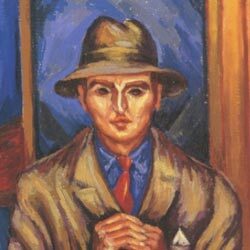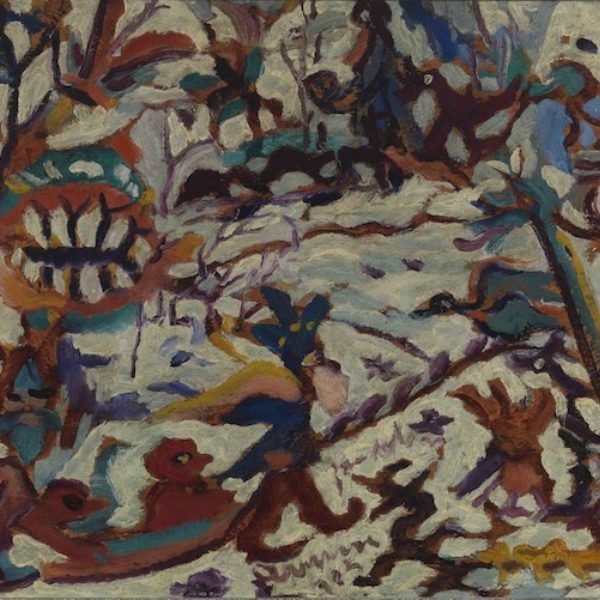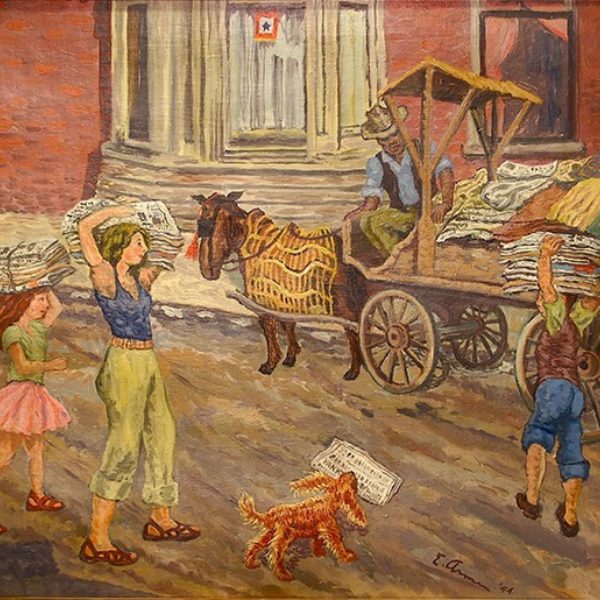
Emil Armin
b. 1883, Radautz, Rumania - d. 1971, Chicago, IL
Emil Armin was born to a pious Jewish family in Romania. His grandfather was a Jewish scribe, copying sacred scrolls. Armin began drawing at the age of 5 and presumably learned wood carving from his father who was an amateur artist. When Armin was 10, his father and mother died a few months apart, leaving him to be raised by older siblings. By age 13 he was working at restaurants and drawing when he had time. At age 15 he moved to Czernowitz, where he worked in a restaurant and took art classes at night. He studied English and French, and old master paintings in museums.
In 1905, at age 21, he joined his brother in Chicago, and worked in his cousin’s store. Armin enrolled in night classes at the School of the Art Institute of Chicago (SAIC) in 1907. Financial difficulties forced him to stop his studies in 1911, only to resume them again in 1916. At SAIC, Armin studied with George Bellows who came to the school as a visiting teacher in 1919. Following his graduation in 1920, Armin became an active member in the modernist art community joining the 57th Street Art Colony in Hyde Park and exhibiting with the Chicago Society of Artists.
Armin visited the Armory show in 1913 multiple times and was puzzled by the conflict between his academic training and the avant-garde artists (Matisse and Cezanne) emerging on the American scene. An exhibition by Russian artist Boris Anisfeld at the Art Institute resolved this conflict. Armin developed as a painter of scenes of Jewish figures in the vein of peasant pictures of saints. Between 1922 and 1949, he exhibited his works at the Art Institute Annuals and joined the No-Jury Society, an organization founded in 1922, to challenge the Institute’s authority. Armin eventually served as president of the Society, exhibiting in all of their shows.
He taught at Chicago’s Hull House in 1925–26, making cartoons and woodblock prints, influenced perhaps by German Expressionism. This influence is seen in an early oil painting, Fairyland, 1922, with its thickly applied oil paint and caricatured figures walking through a colorful snowscape. A landscape painting, Wood Carpet, 1943, blends a faithful representation of nature with modernist strokes of thick paint and vibrant color combinations.
In 1928 Armin traveled to New Mexico where he executed a child-like woodcut, Mountain Farm, Santa Fe. One critic, Samuel Putnam, described Armin as “perhaps the most finely sensitized artist in Chicago . . . with the soul of a peasant and the mind of a philosopher.” He made many images depicting urban life in Chicago, such as Morning Light, 1930s, as well as images celebrating Jewish ritual and biblical themes. Morning Light also displays Armin’s debts to European avant-garde art, with its tilted street perspective and the gestural rendering of human figures, dappled sky, and motley array of buildings.
During the Depression, Armin participated in the Public Works of Art Project (PWAP), and in the easel section of the Works Progress Administration (WPA). In the mid-1930s he remained active in the 57th Street Art Colony some of whose members painted at the Indiana Dunes. Armin, along with other local Jewish artists, formed the American Jewish Art Club in 1940, and he continued to exhibit with them until his death. His work was also shown in group exhibitions at the Renaissance Society in Chicago in 1931, 1941, 1946, and 1962.
In 1945, Armin married Hilda Rose Diamond, a social worker for the Jewish Family and Community Service in Chicago. In the years following Armin’s death in 1971, Hilda worked with the Illinois State Museum to chronicle her husband’s career as an artist, resulting in an exhibition in 1980 that included 72 of his works.
Lisa Meyerowitz
References
Armin, Emil. “Statement.” In Art of Today: Chicago, 1933, by J. Z. Jacobsen, 40. Chicago: L. M. Stein, 1932.
Bulliet, C. J. “Artists of Chicago Past and Present: No. 36: Emil Armin” Chicago Daily News, October 26, 1935.
Illinois State Museum. Emil Armin, biography. http://www.museum.state.il.us/muslink/art/htmls/cc_bio_armin.html
Jacobsen, J. Z. “Chicagoans: Emil Armin—Artist’s Artist.” The Chicagoan (February 1, 1930): 23, 36. Reprinted in Neil Harris, The Chicagoan. Chicago University of Chicago Press, 2010?
McKenna, Maureen A. Emil Armin, 1883–1971. Springfield: Illinois State Museum, 1980.
Putnam, Samuel. Chicago Evening Post. September 21, 1926.
Schloss, Carolyn, and Susan Weininger. “Catalogue.” In Chicago Modern, 1893–1945: Pursuit of the New, edited by Elizabeth Kennedy, p. 85. Chicago: Terra Foundation of American Art, 2004.
Artist image: Detail of Frances Strain, The Visitor (Emil Armin).

